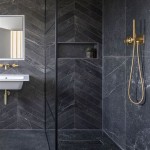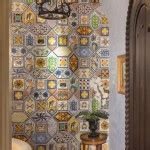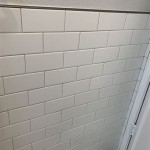The Beauty Of White Floor Tiles: Design Ideas and Applications
White floor tiles offer a versatile and timeless aesthetic for interior design. Their adaptability extends to various spaces, from residential homes to commercial establishments. The neutral palette they provide allows for creative expression through accent colors, furniture choices, and decorative elements. The reflective properties of white tiles can enhance natural light and create a sense of spaciousness, making them a popular choice for smaller rooms or areas with limited sunlight. This article explores the diverse design possibilities of white floor tiles, considering different tile types, patterns, and application scenarios.
The Versatility of White Tile Materials and Finishes
The aesthetic and functional characteristics of white floor tiles are heavily influenced by the material used in their construction. Ceramic, porcelain, marble, and vinyl are common options, each presenting unique advantages and disadvantages based on factors such as durability, water resistance, price, and maintenance requirements. Understanding these differences is essential for selecting the appropriate tile type for a specific application.
Ceramic tiles are a widely accessible and cost-effective option. They are manufactured by firing clay at high temperatures, resulting in a relatively durable and water-resistant surface. Ceramic tiles are available in a wide range of sizes, shapes, and finishes, making them suitable for various design styles. However, they are generally less dense and more porous than porcelain tiles, which may make them more susceptible to staining and chipping, especially in high-traffic areas.
Porcelain tiles are known for their superior durability and water resistance due to the higher firing temperatures and finer clay used in their production. This results in a denser and less porous tile that is resistant to scratches, stains, and wear. Porcelain tiles are suitable for both indoor and outdoor applications, including high-traffic areas such as kitchens, bathrooms, and entryways. They are also available in a wide range of finishes, including polished, matte, and textured options, allowing for diverse design expressions.
Marble tiles offer a luxurious and sophisticated aesthetic with their natural veining and unique patterns. Marble is a metamorphic rock formed from limestone or dolomite, resulting in a durable and visually appealing material. White marble tiles, such as Carrara or Calacatta, are particularly prized for their elegant appearance. However, marble is a relatively porous material, requiring regular sealing to prevent staining and water damage. It is also more susceptible to scratching and etching than ceramic or porcelain tiles, necessitating careful maintenance.
Vinyl tiles provide a cost-effective and resilient flooring option. They are manufactured from synthetic materials, such as PVC, and are available in a variety of styles, including luxury vinyl tiles (LVT) that mimic the appearance of natural materials like wood or stone. Vinyl tiles are water-resistant, easy to clean, and relatively comfortable underfoot. They are a suitable choice for bathrooms, kitchens, and laundry rooms. However, vinyl tiles are generally less durable than ceramic, porcelain, or marble tiles and may be prone to scratching and tearing.
The finish of the white tile also contributes significantly to the overall aesthetic. Polished tiles offer a glossy, reflective surface that enhances light and creates a sense of spaciousness. Matte tiles provide a non-reflective, understated look that is less prone to showing dirt and scratches. Textured tiles offer a tactile surface that can add visual interest and improve slip resistance.
Design Ideas: Patterns and Layouts Using White Floor Tiles
The arrangement of white floor tiles can significantly impact the overall design of a space. Various patterns and layouts can be used to create different visual effects, enhancing the aesthetic appeal and functionality of the room. These include classic patterns like grid, offset, herringbone, and more intricate designs like mosaic or custom layouts.
The grid pattern is a simple and classic layout where tiles are arranged in straight lines, both horizontally and vertically. This pattern creates a clean and organized look, suitable for various styles, from modern to traditional. Using larger format white tiles in a grid pattern can further enhance the sense of spaciousness in a room. The simplicity of the grid pattern also makes it a cost-effective choice for installation.
The offset pattern, also known as a brick pattern or running bond, involves staggering the tiles in each row, typically by half the tile length. This pattern adds a subtle visual interest and can make a room appear longer or wider, depending on the orientation of the tiles. The offset pattern is a popular choice for creating a more relaxed and informal feel. Using different shades of white or adding grout lines in a contrasting color can further accentuate the offset pattern.
The herringbone pattern is a classic and elegant layout where rectangular tiles are arranged in a zigzag pattern, creating a sophisticated look. This pattern is particularly well-suited for hallways, entryways, and bathrooms. The herringbone pattern can be visually striking and adds a touch of luxury to any space. It requires more precise cutting and installation than simpler patterns, potentially increasing the installation cost.
Mosaic patterns involve using small tiles of different shapes and colors to create intricate designs. White mosaic tiles can be combined with other colors to create custom patterns, borders, or focal points. Mosaic patterns are often used in bathrooms, kitchens, and backsplashes. They can add a personalized touch and create a unique and artistic look. The installation of mosaic patterns requires skilled craftsmanship and can be more time-consuming than simpler layouts.
Beyond these common patterns, custom layouts offer endless possibilities for creative expression. Tiles can be arranged in unique geometric shapes, radial patterns, or even to mimic natural textures like wood grain or stone formations. Custom layouts allow for a highly personalized design that reflects the individual style and preferences of the homeowner. These layouts often require detailed planning and skilled installation, but the results can be visually stunning and truly unique.
Applications and Design Considerations for White Floor Tiles in Different Spaces
The suitability of white floor tiles varies depending on the specific room and its functional requirements. Considerations such as traffic levels, moisture exposure, and desired aesthetic style should influence the choice of tile material, finish, and layout. Different spaces, like kitchens, bathrooms, living rooms, and entryways, each present unique design opportunities and challenges.
In kitchens, white floor tiles can create a bright and clean environment, perfect for food preparation and entertaining. Porcelain tiles are a particularly good choice for kitchens due to their durability, water resistance, and ease of cleaning. Matte or textured finishes are recommended to provide slip resistance and prevent accidents. White tiles can be paired with colorful cabinets, countertops, and backsplashes to create a vibrant and personalized kitchen design. Large format tiles can minimize grout lines, making the floor easier to maintain and further enhancing the sense of spaciousness.
Bathrooms benefit from the reflective properties of white floor tiles, enhancing the natural light and creating a spa-like atmosphere. Porcelain or vinyl tiles are well-suited for bathrooms due to their water resistance and durability. Smaller tiles or mosaic patterns can be used to create intricate designs and add visual interest. Textured finishes are essential to provide slip resistance and ensure safety. White tiles can be paired with contrasting grout lines or colorful accessories to create a stylish and functional bathroom design.
Living rooms offer a blank canvas for design expression with white floor tiles. Ceramic, porcelain, or even marble tiles can be used, depending on the desired aesthetic and budget. Large format tiles in a grid or offset pattern can create a seamless and modern look. White tiles can be paired with area rugs, furniture, and artwork to add warmth and personality to the living room. Polished tiles can enhance the natural light and create a sense of spaciousness, while matte tiles offer a more subtle and understated look.
Entryways are high-traffic areas that require durable and easy-to-clean flooring. Porcelain tiles are an ideal choice for entryways due to their resistance to scratches, stains, and wear. Consider textured tiles or incorporate a textured insert mat to provide slip resistance, particularly in wet or snowy climates. White tiles can be paired with a contrasting border or decorative elements to create a welcoming and stylish entryway. Strategically placed rugs can help to protect the tiles and add warmth to the space.
When using white floor tiles in any space, it is important to consider the overall color scheme and lighting. White tiles can amplify natural light, but they can also appear stark or cold if not balanced with warm colors and adequate lighting. Using a variety of textures and finishes can add visual interest and prevent the space from feeling too monotonous. Regular cleaning and maintenance are essential to keep white tiles looking their best and prevent staining. By carefully considering these factors, white floor tiles can be used to create beautiful and functional spaces that are both timeless and stylish.

White Tile Bathroom Ideas For Every Budget Stone Depot

Kitchen Floor Tile Ideas 2025 Marble Systems

White Marble Flooring Ideas For Any Style Budget Stone Tile Depot

White Marble Flooring Ideas For Any Style Budget Stone Tile Depot

White Kitchen Tiles Ideas Quorn Stone

Top 20 Marble Tile Bathroom Ideas Stone Depot

Things To Remember Caring For White Floor Tiles

40 Chic Bathroom Tile Ideas Wall And Floor Designs

White Kitchen Tiles Ideas Quorn Stone

Kitchen Floor Tile Ideas 2025 Marble Systems
Related Posts







